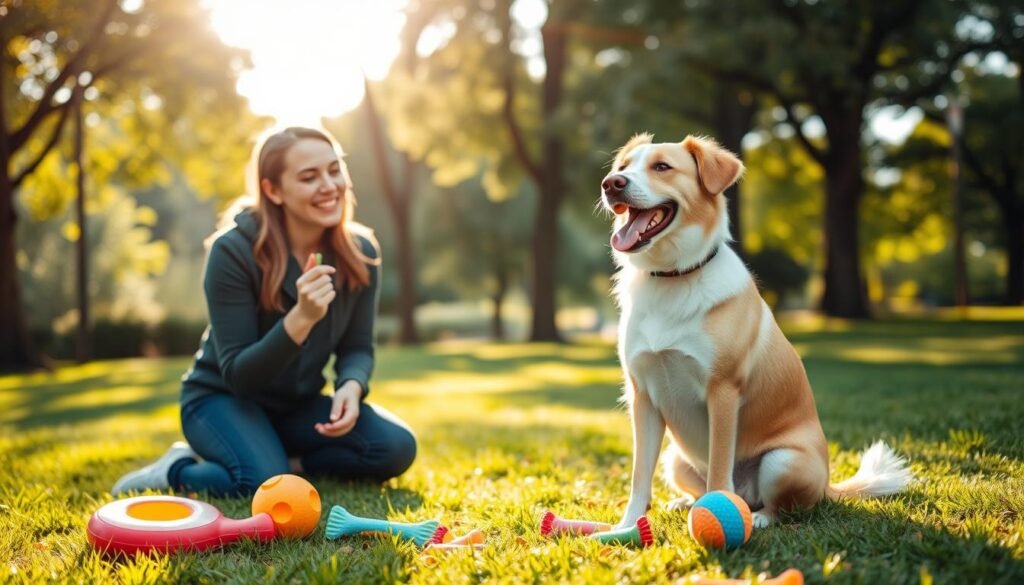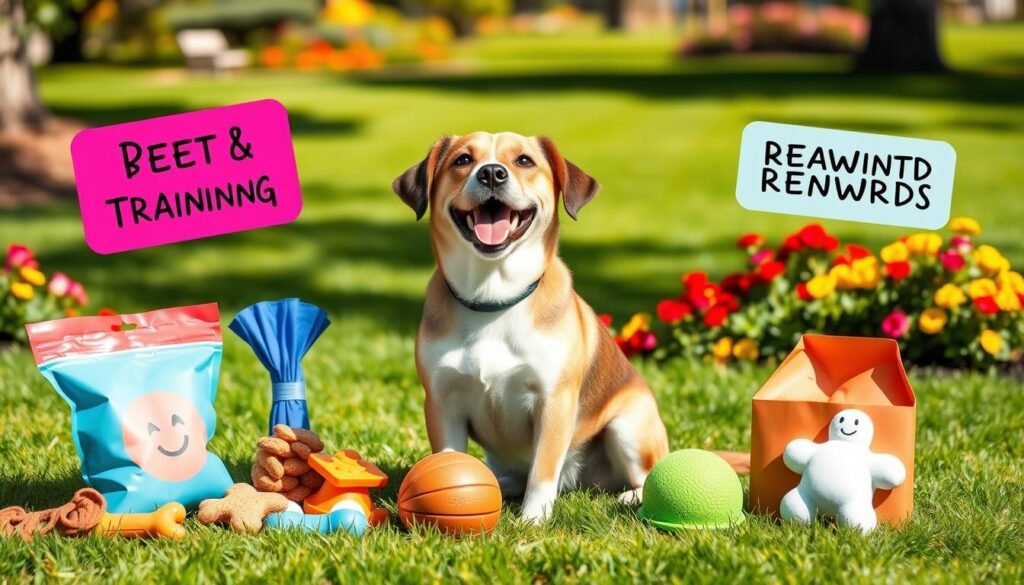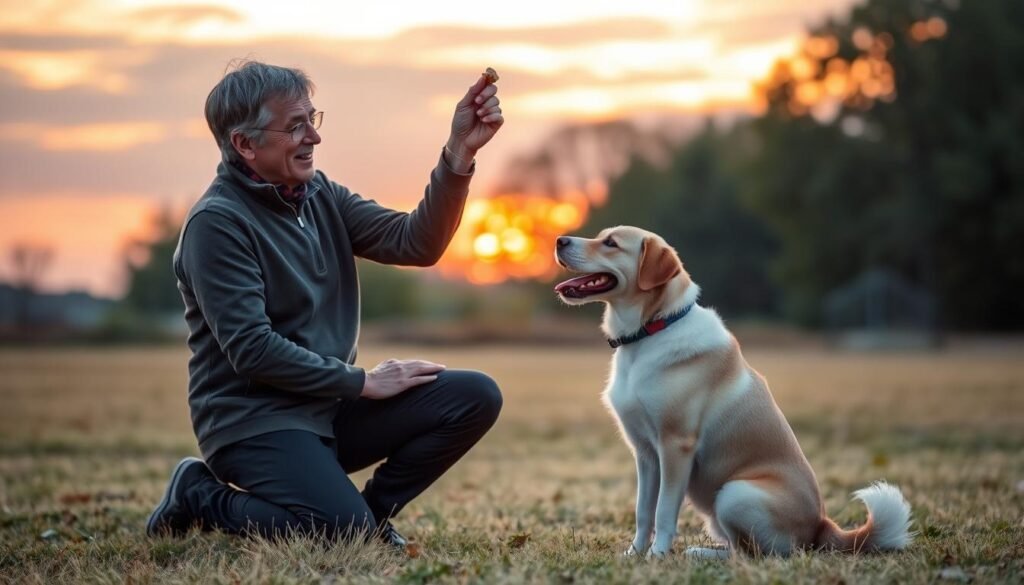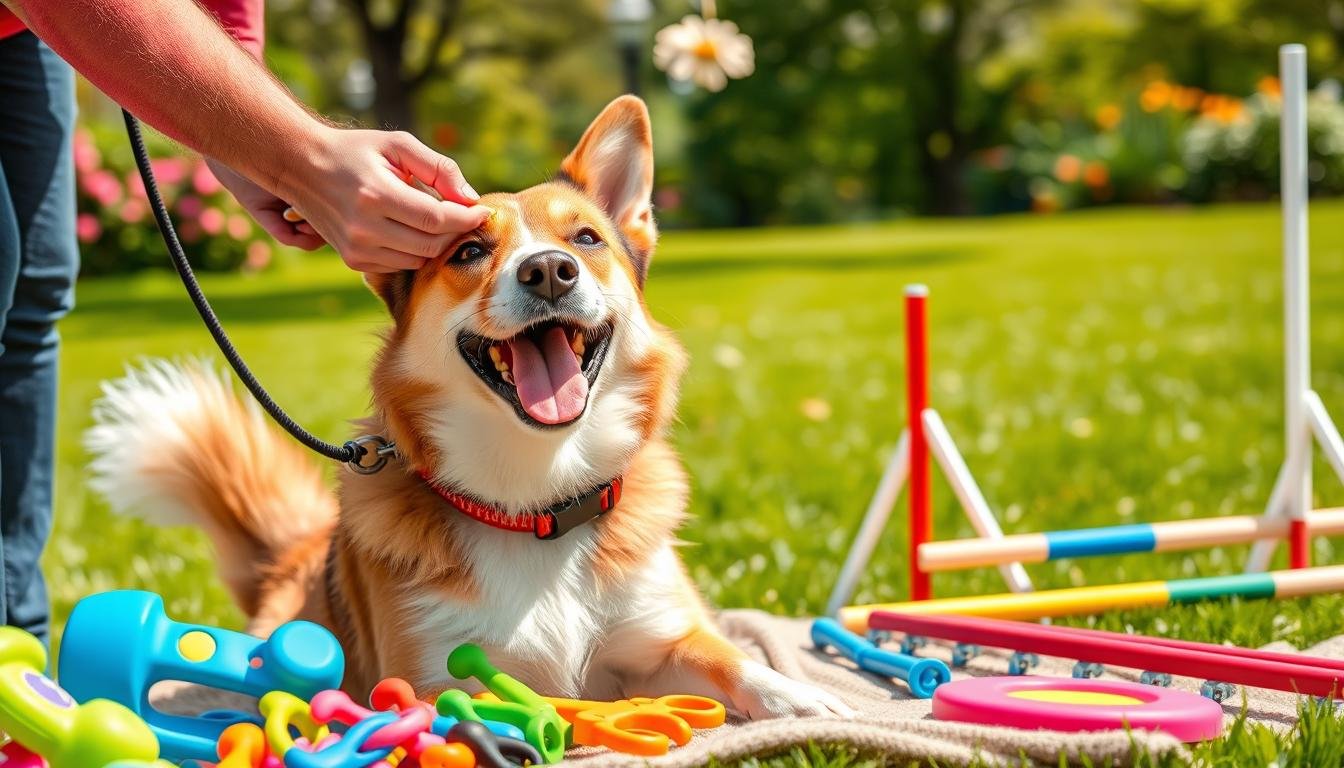Did you know that a study in the Journal of Veterinary Behavior found dogs trained gently show fewer bad behaviors? This shows how crucial kindness and empathy are in training your pet. By using punishment-free training, you can create a strong bond with your dog based on trust and respect, not fear.
Welcome to the world of positive reinforcement. Here, every command or wag of the tail strengthens your connection with your dog. This approach is different from old methods that scare dogs into behaving.
Positive reinforcement rewards your dog for good behavior. This not only makes your pet happy but also makes training more effective. By giving treats or praise when your dog does well, you’re building a strong bond. This method is loved by both expert trainers and pet owners for its kind nature and lasting results.
Quick Recommendation: This blog article contains tips for training your dogs. If you are looking for a more comprehensive training program, we strongly recommend K9 Training Institute.
Key Takeaways
- Studies have shown that gentle dog training methods lead to less problematic behaviors.
- Punishment-free dog training nurtures a healthier relationship between you and your pet.
- Positive reinforcement rewards good behavior, enhancing training effectiveness.
- Building a bond with your dog through training creates lasting trust and communication.
- Choosing positive techniques over punitive measures can lead to happier, better-behaved dogs.
Understanding Positive Reinforcement
At the heart of creating a happy and well-behaved pet is knowing how to properly apply positive reinforcement in dog training. This method focuses on rewarding good behavior, not punishing bad. When you use positive reinforcement, you give your dog treats or praise for good actions. This encourages them to do it again.
The key to this technique is the timing and consistency of rewards. These rewards help reinforce better behavior.
Understanding the science behind positive reinforcement—operant conditioning—gives us a deeper insight. It shows why this method is so effective. In operant conditioning, an animal’s behavior is shaped by the consequences of that behavior. This encourages good behavior and discourages bad.
By using positive reinforcement in dog training, you choose a humane and effective method. Studies show it strengthens your bond with your dog and makes them happier. Remember, being consistent is crucial for success. It helps your dog understand and meet your expectations.

Consistency means rewarding the same behaviors every time. Irregular rewards can confuse and slow learning. The power of reward-based training comes from its simplicity and love. It builds a nurturing relationship where your dog feels secure and motivated to learn.
Establishing a Reward System
Training your dog can be easier with a good dog training reward system. This system uses treats as training aids to incentivizing obedience. You can reward your dog with treats, toys, or praise. Knowing what motivates your dog is key to a successful system.

Choosing the right rewards is important. For dogs that love food, small treats work well. Playful dogs might enjoy toys like balls or tug ropes. Some dogs might prefer praise or affection.
Timing your rewards is crucial. Reward your dog right after they obey a command. This helps them connect the behavior with the reward. As they learn, start using rewards less often and praise more.
The main aim of a reward system is to improve obedience and strengthen your bond with your dog. By picking the right rewards and timing them well, you’ll have fun and successful training sessions.
Basic Obedience Training with Positive Reinforcement
Starting to teach basic obedience commands can be both fun and tough. Using positive dog training methods helps you communicate better with your dog. It also strengthens your bond. Teaching sit and stay is key for safety and good manners.

To start, teach ‘sit’. It’s simple and useful. Begin in a quiet spot without distractions. Hold a treat near your dog’s nose, then move it up. This makes their head go up and their bottom down.
When they sit, say “sit” and give them the treat. Share praise too. Practice this often in short, positive sessions.
Then, move on to ‘stay’. Make sure your dog knows how to sit first. Say “stay” firmly but gently, and take a few steps back. If they stay, reward them with a treat and praise.
Keep increasing how long and far you can go back. Always reward them for staying. This builds trust and understanding.
Remember, patience and consistency are key. Every dog learns at their own pace. Positive reinforcement encourages good behavior. If you hit a snag, stay calm and try again.
Also, make training a part of your daily routine. Regular practice reinforces what they’ve learned. With the right approach, your dog will learn basic commands well. This makes life easier and more fun for both of you.
Quick Recommendation: This blog article contains tips for training your dogs. If you are looking for a more comprehensive training program, we strongly recommend K9 Training Institute.
Teaching Tricks and Advanced Skills
When you move from basic commands to advanced dog training, positive reinforcement is still crucial. Teaching your dog tricks or complex behaviors is very rewarding. Whether it’s fetching a ball or doing a ‘roll over’ perfectly, using positive reinforcement for complex tasks makes learning fun and rewarding for your dog.
Begin by breaking down dog tricks into smaller steps. For example, if you want to teach your dog to fetch, start with having them hold an object. Then, teach them to pick it up from the ground and bring it back to you. Each step should be clearly defined and rewarded, keeping the training exciting and encouraging.
Success with advanced tasks depends on consistency and patience. Every dog learns at their own pace, so adjust training sessions to fit their learning style. Celebrate each small victory with treats, affection, and lots of praise. This makes training enjoyable and memorable, encouraging them to learn and please you.
As you get better, keep training sessions short and fun. This keeps your dog enthusiastic, especially when doing advanced dog training exercises. Remember, the goal is to support and encourage their learning, not overwhelm them.
By using positive reinforcement for complex tasks, you improve your dog’s skills and strengthen your bond. So, grab some treats and start teaching—it’s going to be a rewarding adventure!
Addressing Common Behavioral Issues
Understanding why dogs bark and chew is key to fixing bad behavior. Using positive methods to change their actions is more than just stopping the problem. It’s about teaching them better ways to act.
Identifying what makes your dog bark or chew is crucial. Is it anxiety, wanting attention, or defending their territory? Each reason needs a special approach to change their behavior. Instead of scolding, try to redirect their focus.
If your dog chews on furniture, give them chew toys instead. These toys should be fun and keep them busy. This way, they won’t damage your furniture. For barking, reward them when they’re quiet, especially in situations that usually make them bark.
Using positive methods to correct bad behavior strengthens your bond with your dog. It makes them feel safe and understood. This builds trust and encourages them to act in the ways you want, proving the power of positive behavior change.
Dog Training Tools and Resources
Having the right dog training aids can greatly help when training your dog. There are many tools and technologies available. One key tool is a clicker. Using clickers for training helps you communicate clearly with your dog. It marks good behaviors right away.
Clickers are a must-have for dog trainers today. They are easy to use, affordable, and very effective. The clicker’s sound grabs your dog’s attention, signaling a reward is coming. This helps your dog learn faster.
Other dog training aids include harnesses, which help control your dog during walks. Training apps and online platforms are also great recommended training resources. They offer guidance and structured training you can do at home. Apps often have video tutorials that show how to train correctly.
While tools are helpful, they shouldn’t replace your direct interaction with your dog. Your time and consistency are key to training. Using a mix of dog training aids and personal interaction will get the best results. This way, your dog will be well-trained and happy.
Integrating Positive Reinforcement into Daily Life
Adding training to your daily life is more than just teaching your dog. It’s about making it a natural part of your day. This way, you and your dog can grow together in a loving and consistent way. Every moment, whether at home, on a walk, or during meals, is a chance to teach and praise your dog.
Start by adding small training moments to your daily activities. For example, use the “sit” command before meals or when guests come over. This not only reinforces good behavior but also keeps your dog focused and ready to learn. Also, practicing commands like “heel” during walks can greatly improve their obedience.
It’s important that everyone in your home agrees on this training method. Being consistent is crucial because mixed signals can confuse your dog. Ensure all family members use the same commands and rewards. This helps your dog learn faster and strengthens your bond with them.
The aim is to make training a regular part of your life, not just special sessions. This approach makes the most of your time with your dog and helps them learn faster. It makes these lessons a natural part of their behavior.
Conclusion
We’ve looked at how positive reinforcement changes dog training. By using rewards and kindness, you teach obedience and make lasting changes. This method also strengthens your bond with your dog, creating trust and encouraging learning.
This approach to training is very beneficial. It makes your pet happy and cooperative, and the changes last. It’s a win-win that goes beyond just following commands. It’s about respect and motivation, leading to a happy life together.
Keep learning and training with your dog. Be consistent, patient, and friendly. Effective dog training is about unlocking your dog’s full potential. With rewards and positive reinforcement, you’re on the right path. Here’s to many happy years together!
Quick Recommendation: This blog article contains tips for training your dogs. If you are looking for a more comprehensive training program, we strongly recommend K9 Training Institute.

